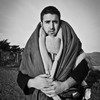Racecar driver Toby Fray gets out to observe the wreckage after attempting to veer off course to avoid silt pits at mile marker 205 of the Baja 1000
The Desert Dingoes tune up the Bug before the race at a fellow Class 11 racer's compound in Ensenada, Baja California
Desert Dingoes, from left to right: Romy Frederick, Dennis "Crusty" Lange, Chuck Gianni, Toby Fray, Gil Medrano, Rosh Edwards, and Cyrus Roohi
Motorcyclists take off first in 30-second intervals, starting with last year's winner
Local children cheer on Trophy Trucks at a rural crossroads on the Baja Peninsula
The Desert Dingo Bug tears down the course, trying to make up time after setbacks and repairs
After getting destroyed by a booby trap, racecar driver Gil Medrano and co-driver Chuck Gianni lick their wounds while the team chase truck drags the Bug to the nearest pit stop for repairs
Near midnight, Romy Frederick and the Desert Dingoes remove the Bug's engine and replace its transmission on the side of the course.
Race car driver Toby Fray, delirious after driving through the night, takes a moment after the Bug's final breakdown at Race Mile 205
Toby Fray gives local children a ride in the Bug after the Desert Dingoes bow out of the Baja 1000
